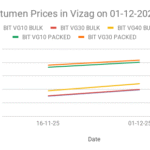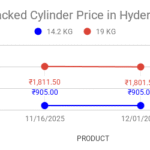What is Diesel? What are the grades of Diesel?
Diesel is a fuel suitable for burning in diesel or compression ignition engines. Petroleum diesel fuels may be distillates or blends of distillates and residual fuels. High Speed Diesel (HSD) and Light diesel oil (LDO) sold main diesel grades marketed in India.
In a compression ignition engine, Cylinder drawn air alone. Cylinder compress Air until it reaches a high temperature, about 500 degrees Celsius. Next, finely atomized fuel is injected at a very high pressure, and it’s ignited by the heat of compression, which is why it’s called compression ignition.
What is diesel or HSD? Where does diesel or HSD use?
HSD is a 100% distillate fuel. HSD is a fuel for high-speed diesel engines operating above 750 rpm. Buses, lorries, generating sets, locomotives, pumping sets etc are the examples. Gas turbine requiring distillate fuels normally make use of HSD as fuel.
How to check Diesel Fuels?
When fuel is injected into the combustion chamber of a diesel engine, ignition does not occur immediately. The interval between the commencement of fuel injection and the commencement of combustion is known as the ” ignition delay”. It is a measure of the ignition quality of the fuel.
Diesel specification
1. CETANE NUMBER
The most accurate method of assessing the ignition quality of a diesel fuel is by measuring its cetane number in a test engine. The higher the cetane number the higher the ignition quality. The cetane number of a fuel is defined as the percentage of cetane, arbitrarily given a cetane number of 100, in a blend with alphamethyl – naphthalene (cetane number -0), which is equivalent in ignition quality to that of the test fuel.
2. VISCOSITY
Defined simply, viscosity means resistance to flow or movement. In metric system, centistoke is the unit for its measurement. It is function of time taken in seconds for a given volume of oil to flow through a calibrated viscometer under specified conditions. Viscosity depends on temperature and decreases as the temperature increases, so no numerical value has any meaning unless the temperature is specified.
3. CARBON RESIDUE
Different fuels have different tendencies to crack and leave carbon deposits when heated under similar conditions. This property is normally measured by the Conradson or the Ramsbottom coke tests. In these tests, a sample of the fuel is heated without contact with air under specified conditions and the weight of carbon residue remaining after the test is expressed as a percentage of the weight of the sample.
4. VOLATILITY
As a rule, the higher the viscosity of a liquid fuel, the lower its volatility. Therefore, provided the viscosity lies within specified limits, a satisfactory volatility is automatically ensured. However, the percentage recovered at some particular temperature e.g., 366 deg C, is specified in the case of HSD mainly to control engine fouling due to incomplete combustion of the higher boiling components.
5. TOTAL SULPHUR
This is significant because it governs the amount of sulphur oxides formed during combustion. Water from combustion of fuel collects on the cylinder walls, whenever the engine operates at low jacket temperatures. Under such conditions, sulphurous and sulphuric acids are formed, which attack the cylinder walls and piston rings, promote corrosion, and thus cause increased engine wear and deposits. Total sulphur is expressed as a percentage of the weight of the fuel sample.
6. CORROSIVE SULPHUR
It is important that diesel fuels shall be free of these sulphur compounds which in themselves attack metal parts of the engine or the fuel system. This characteristic is tested by the Copper Strip Corrosion Test, a severe discoloration or pitting of the polished strip indicating the presence of corrosive sulphur compound in the fuel.
7. ACIDITY
This should be low in order that corrosion of metals in contact with the fuel during storage and distribution is minimised.
8. INORGANIC OR MINERAL ACIDITY
Where diesel fuels are treated with mineral acid as part of the refining procedure, traces of mineral acid remaining in the final product would obviously be undesirable. Hence, zero limit is usually specified for this property.
9. ORGANIC ACIDITY
This is due to the naphthenic type which are constituents of crude petroleum. Their presence in small amounts is not necessarily an indication of improper refining or poor quality. Although much weaker than mineral acids, they may attack galvanised metal and this is why the use of galvanised containers for the storage of diesel fuels is not recommended.
10. ASH CONTENT
Ash is a measure of the incombustible material present in a fuel and is expressed as a percentage of the weight of the fuel sample. In the case of distillate fuels, it usually consists of rust, tank scale or sand which settles out readily. Blends of distillate and residual fuel, e.g., LDO may additionally contain metal oxide derived from oil soluble and insoluble metallic compounds. Ash is significant because it can give rise to deposit problems such as abrasion, malfunctioning of injectors and high temperature corrosion, particularly with residual fuels.
11. SEDIMENT AND WATER
These are absolutely undesirable contaminants and should be as low as possible. The higher the specific gravity and viscosity of a fuel, the greater the quantities of water and sediment it can hold in suspension. Large quantities of sediment can affect the combustion of the fuel, and if abrasive, may cause excessive wear of closely fitting parts of fuel pumps and injectors. It may also clog filters and build up deposits in tanks and piping.
12. POUR POINT
The pour point of a fuel is the lowest temperature at which it will pour or flow when chilled under prescribed conditions. It is a very rough indication of the lowest temperature at which a given fuel can be readily pumped. However, since practical conditions are quite different from those under which the laboratory test is conducted, many fuels can be pumped at temperatures well below their laboratory pour point.
Sometime cloud point is measured. This is the temperature at which paraffin wax begins to crystallise or separate from solution when the fuel is chilled under prescribed conditions. This may settle out in the fuel system and cause blockage of filters – leading to malfunctioning or stalling of the engine.
13. COLD FILTER – PLUGGING POINT
The cold filter plugging point (CFPP) is defined as the highest temperature at which the fuel, when cooled under prescribed conditions, either will not flow through the filter (45 microns) or will require more than 60 seconds for 20 ml to pass through. This is the temperature at which wax crystals begin to cause blockage of filter.
14. FLASH POINT
This has no bearing on performance but is important largely from the point of view of safety in handling the fuel and minimum values are usually specified in the specification.
The flash point of High-speed diesel is stipulated as min. 32 deg C and thus it falls under the category of class of petroleum products. While other diesel fuels have a flash point of min. 66 deg. C and hence fall in the category of class of petroleum products.
15. SPECIFIC GRAVITY
This is defined as the ratio of the weight of a given volume of oil to the weight of the same volume of water at a given temperature. Another index for measuring this characteristic is by Density, mass per unit volume at a standard temperature. Specific Gravity / Density is of limited usefulness as a direct measure of diesel fuel quality.
SPECIFICATION FOR AUTOMOTIVE DIESEL FUEL (BS VI) (IS 1460-2005)
| Characteristics | Unit | Bharat Stage II | Bharat Stage III | Bharat Stage IV | Bharat Stage VI† |
| Implementation date | 2001 (selected cities), 2005 (nationwide) | 2005 (selected cities), 2010 (nationwide) | 2010 (selected cities), 2017 (nationwide) | 2020?(nationwide) | |
| Ash, max | % mass | 0.01 | 0.01 | 0.01 | 0.01 |
| Carbon Residue (Ramsbottom) on 10% residue, max † | % mass | 0.3 | 0.3 | 0.3 | 0.3 |
| Cetane Number (CN), min | – | 48* | 51 | 51 | 51 |
| Cetane Index (CI) min | – | 46* | 46 | 46 | 46 |
| Distillation 95% vol. Recovery at °C max | °C | – | 360 | 360 | 370 |
| Flash point Abel min | °C | 35 | 35 | 35 | 35 |
| Kinematic Viscosity @ 40 °C | cst | 2.0-5.0 | 2.0-5.0 | 2.0-4.5 | 2-4.5 |
| Density @ 15 °C | Kg/m3 | 820-860 (820-870)* | 820-845 | 820-845 | 820-860 |
| Total Sulfur max | mg/kg | 500 | 350 | 50 | 10 |
| Water content max | mg/kg | 0.05% vol | 200 | 200 | 200 |
| Cold filter plugging point (CFPP) a) Summer max b) Winter max | °C °C | 18 6 | 18 6 | 18 6 | 18 6 |
| Total contaminations max | mg/kg | – | 24 | 24 | 24 |
| Oxidation stability max | g/mg3 | – | 25 | 25 | 25 |
| Polycylic Aromatic Hydrocarbon (PAH) max | % mass | – | 11 | 11 | 11 |
| Lubricity corrected wear scar diameter (wsd 1 4) @ 60 °C max | µm (microns) | 460 | 460 | 460 | 460 |
| Copper Strip corrosion for 3 hrs @ 50 °C | Rating | Not worse than No. 1 | Class I | Class I | Class I |





